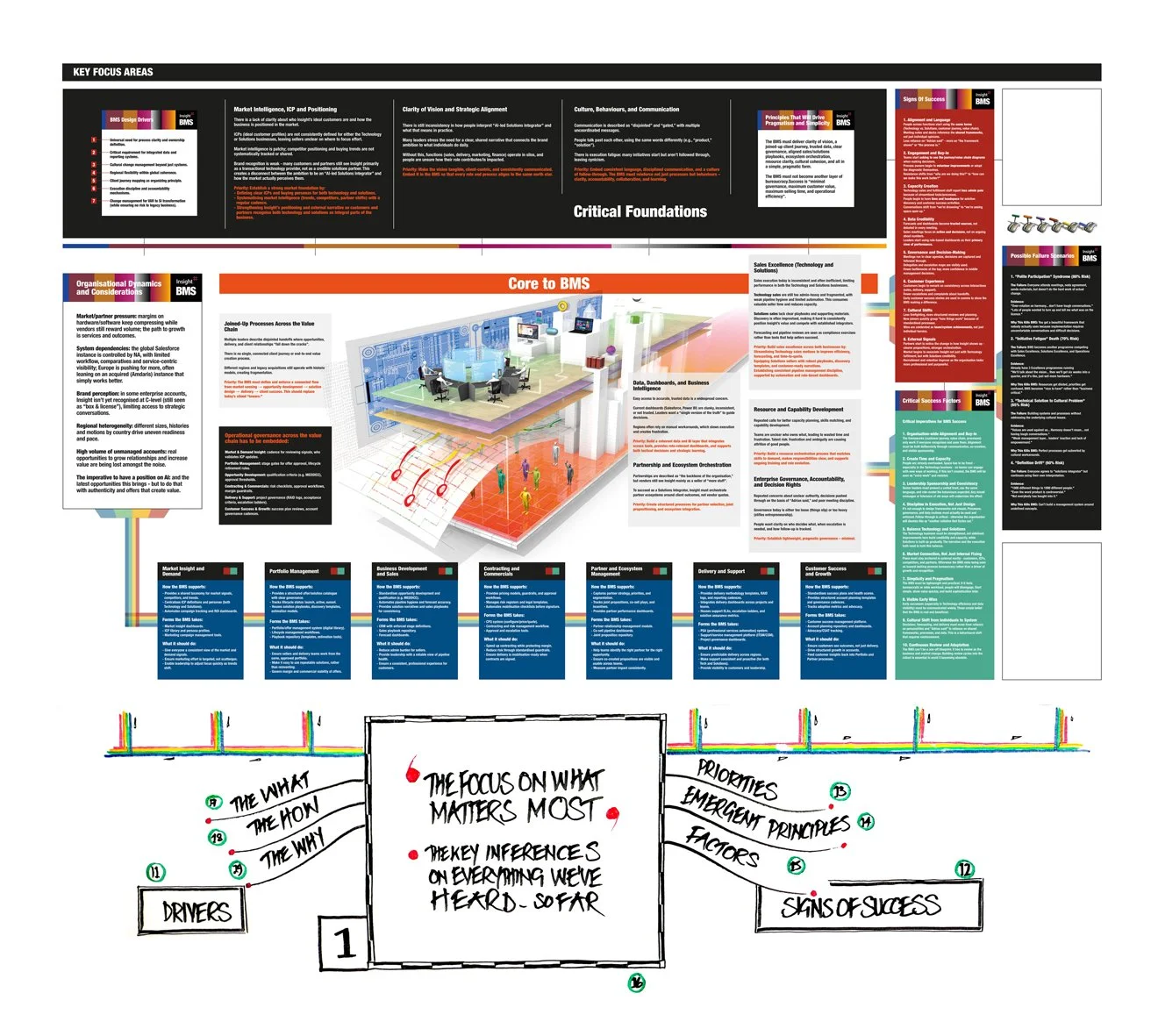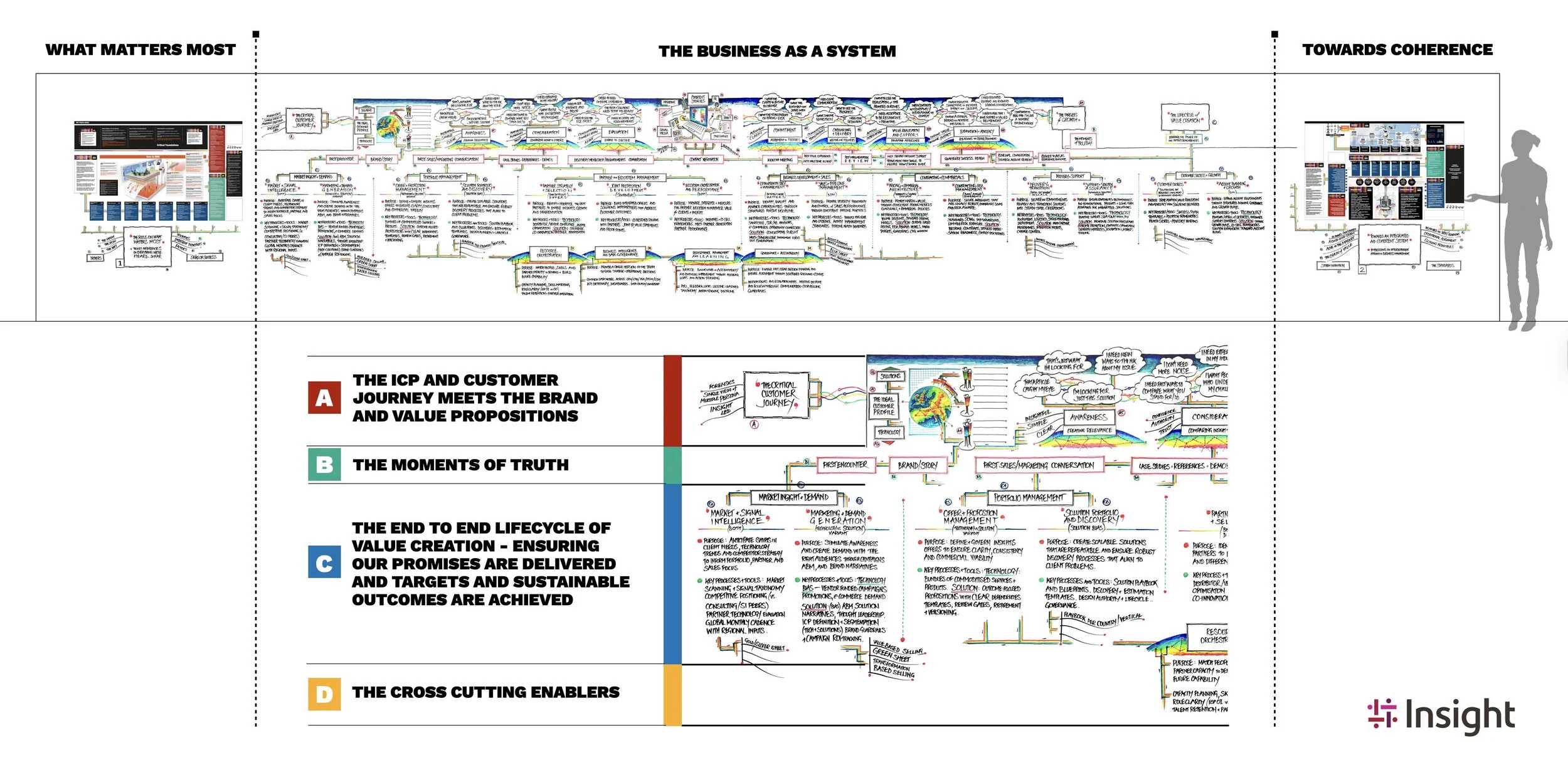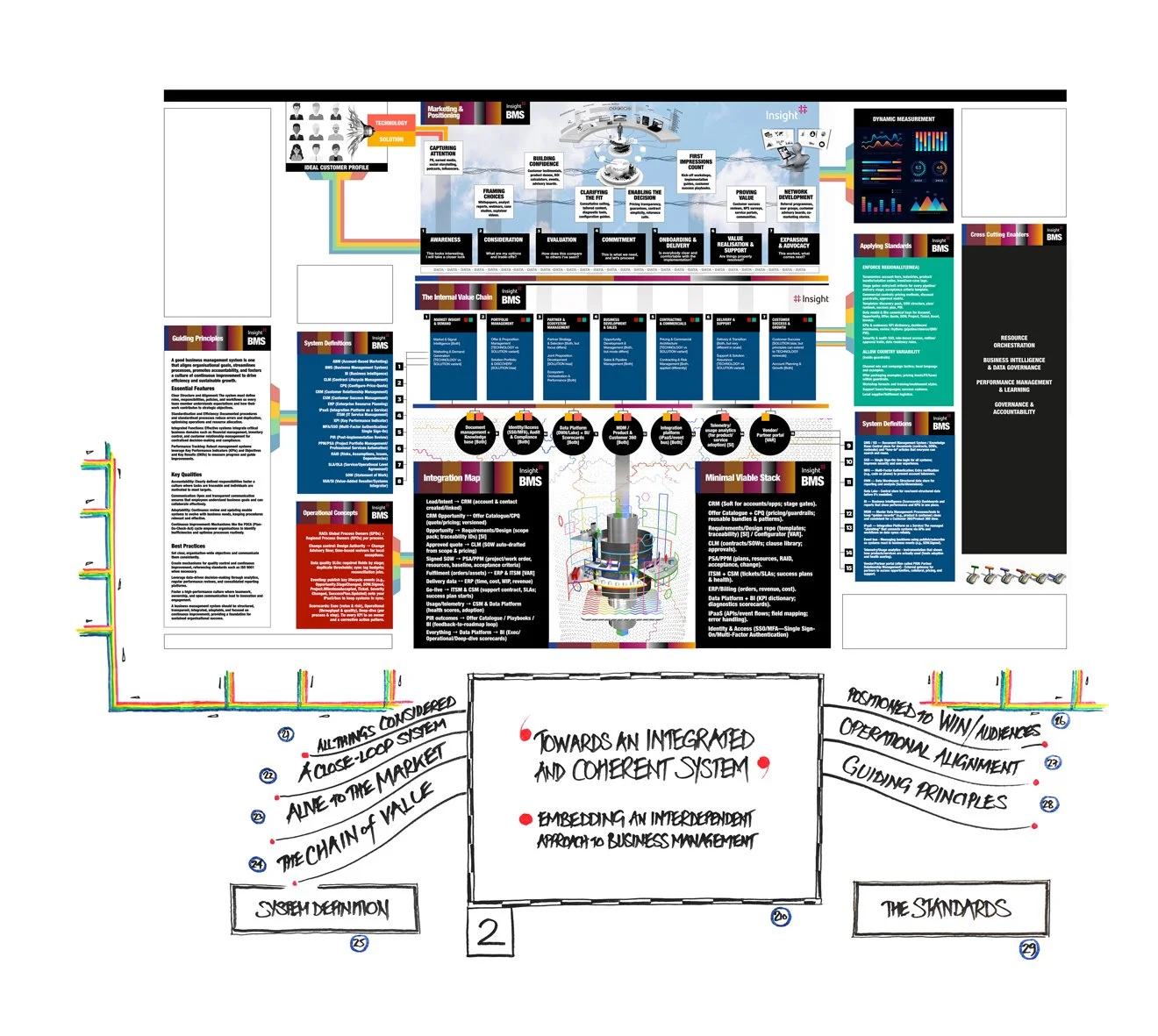The Story of the BMS:
What Matters Most
Starting with the Why
Every transformation begins with clarity about what matters most. For Insight, the challenge has never been activity — it’s coherence. The business is full of capability, intelligence, and expertise, but these strengths can only drive growth if they’re connected.
The BMS exists to bring that connection — to focus the organisation around shared intelligence, consistent processes, and measurable outcomes.
This is not about adding more tools. It’s about building a system that aligns purpose, performance, and growth.
The Drivers: What We’ve Heard
The foundations of the BMS come directly from what the business has been saying — the patterns and pain points heard across regions, functions, and teams.
They fall into three core drivers:
The What: Clear definition of the processes, roles, and outcomes that make up Insight’s value chain.
The How: Consistent standards, shared enablers, and measurable disciplines that make work repeatable and scalable.
The Why: A unifying focus on growth, value creation, and client impact that ties everything together.
These insights form the blueprint for what the BMS must solve.
The Critical Foundations
Every system needs a strong base. The BMS rests on three foundational pillars:
Market Intelligence, ICP, and Positioning: Knowing precisely who we serve, how we’re perceived, and what differentiates us.
Clarity of Vision and Strategic Alignment: Ensuring that everyone in Insight, from sales to delivery, understands the same ambition and how their work contributes to it.
Culture, Behaviour, and Communication: Building shared habits — the way we speak, plan, and act — that enable collaboration and trust across teams.
Together, these create the conditions for focus and alignment.
The Core of the System
At the heart of the visual is the Core to BMS architecture — a representation of Insight’s operating model. It captures how every function connects to the others through defined stages of the Value Chain:
Market Insight & Demand
Portfolio Management
Business Development & Sales
Contracting & Commercials
Partner & Ecosystem Management
Delivery & Support
Customer Success & Growth
Each element has clear ownership, defined inputs and outputs, and shared dependencies. This is the structural foundation for consistent execution.
The Enablers That Hold It Together
Surrounding this core are the cross-cutting disciplines that make the system intelligent and adaptive:
Sales Excellence: Driving consistency through frameworks, playbooks, and performance management.
Resource and Capability Development: Ensuring people, partners, and skills are aligned to demand.
Data, Governance, and Accountability: Maintaining one version of the truth and clear decision-making rights.
These are the control systems that make Insight scalable and predictable.
The Focus on What Matters Most
All of this boils down to one central aim:
To focus the business on what matters most — the interdependencies that create value and drive growth.
By identifying the key priorities, emergent principles, and signs of success, the BMS enables Insight to measure progress, close gaps, and embed the disciplines that fuel sustainable performance.
The Outcome: A System That Learns
When complete, the BMS will give Insight a living, learning framework — one that connects data, decisions, and delivery.
It will show where performance is accelerating and where it’s stalling, highlight where investment makes the most impact, and make the entire business system visible to everyone who works within it.
This is how we align the organisation around growth, remove friction, and create the feedback loops that keep us learning faster than the market changes.
The Business Management System:
How Growth Becomes Systemic
At its simplest, the Business Management System is the way we make Insight work as one joined-up organisation — built around our clients, not our org chart.
It connects every part of the business — from market insight and sales to delivery, customer success, and partner ecosystems — into a single, intelligent operating model.
The purpose is straightforward: to drive growth by design, not by chance.
When we understand how the business operates as a system — and wire it directly to the needs and aims of our Ideal Customer Profiles (ICPs) — we create the conditions for sustainable performance. Every process, decision, and hand-off can then be traced back to the same goal: delivering value for our clients and growth for Insight.
But connection is the key.
The data that runs through this system — from market signals to sales activity, partner performance, delivery outcomes, and customer advocacy — becomes the shared intelligence that reveals what’s working and what’s not. It exposes the blockers and barriers slowing progress, the gaps and inefficiencies hidden in our workflows, and the opportunities to perform better, faster, and smarter.
The BMS is not another layer of reporting. It’s the mechanism that links strategy to execution, turns information into action, and ensures that growth in revenue, relationships, and capability is the natural outcome of how we operate every day.
THE CUSTOMER JOURNEY
AWARENESS
“I expect you to show me relevant Insight, not generic noise. I want to discover new ideas and partners that can help me solve problems I may not even fully understand yet. I need clear, simple messages that make it obvious what you stand for. I want to quickly understand what makes you different from others in the market. Stage summary: I become aware of Insight and its relevance to my needs.”
CONSIDERATION
“I need confidence that you understand my industry and my challenges. I expect credible examples of how you’ve helped others like me. Stage summary: I start to compare Insight with other options.”
EVALUATION
“I expect a consultative process that shapes requirements with me. I need to see that your Technology and Solutions portfolio fits my problems. I want a partner who listens, not just sells. Stage summary: I am engaged in exploring whether Insight can meet my requirements.”
COMMITMENT
“I want clarity on what I’m buying and the outcomes it will deliver. I need transparent pricing and realistic risk assessments. I expect mobilisation readiness when I sign. Stage summary: I agree to move forward with Insight’s solution.”
ONBOARDING & DELIVERY
“I need communication, progress visibility, and issue resolution. I want a smooth transition where everyone knows their role. I expect delivery on time, with no surprises. Stage summary: I received what was promised and got set up to use it.”
VALUE REALISATION & SUPPORT
“I want to see agreed business outcomes, not just technical completion. I expect continuity — not re-explaining my context. I need responsive support and proactive assurance. Stage summary: I experience outcomes and have responsive help when needed.”
EXPANSION & ADVOCACY
“I need structured reviews and forward-looking conversations. I want new ideas to keep growing. I expect to feel valued enough to recommend you. Stage summary: I buy more, renew, and recommend Insight to others.”
MOMENTS OF TRUTH
First Encounter
Brand Story
First sales/marketing conversation
Case studies, References, or Demonstrations
Discovery workshop/requirements conversation
Contract Negotiation
Kick-off meeting
First Issue experience
First milestone delivery
Post-implementation review
First serious support incident
Quarterly success review
Renewal conversation
Strategic account review
Request to act as a reference/advocate
MARKET INSIGHT & DEMAND
Market & Signal Intelligence (Both)
Purpose: Anticipate shifts in client needs, technology trends, and competitor strategies to inform portfolio, partner, and sales focus.
Key Processes/Tools:
Market scanning & signal taxonomy
Competitive positioning (vs. consulting/SI peers)
Partner/technology evaluation
Global monthly cadence with regional inputs
Marketing & Demand Generation (TECHNOLOGY vs. SOLUTION variant)
Purpose: Stimulate awareness and create demand with the right audiences through campaigns, ABM, and brand narratives.
Key Processes/Tools:
TECHNOLOGY bias: vendor-funded campaigns, promotions, e-commerce demand.
SOLUTION bias: ABM, solution narratives, thought leadership, ICP definition & segmentation (Tech + Solutions), brand guardrails & campaign ROI tracking.
PORTFOLIO MANAGEMENT
Offer & Proposition Management (TECHNOLOGY vs. SOLUTION variant)
Purpose: Define and govern Insight’s offers to ensure clarity, consistency, and commercial viability.
Key Processes/Tools:
TECHNOLOGY: bundles of commoditised services/products.
SOLUTION: outcome-focused propositions with clear dependencies.
Templates, review gates, retirement/versioning.
Solution Portfolio & Discovery (SOLUTION bias)
Purpose: Create scalable, repeatable solutions and ensure robust discovery processes that align to client problems.
Key Processes/Tools:
Solution playbooks & blueprints
Discovery & estimation templates
Design authority & lifecycle governance
PARTNER & ECOSYSTEM MANAGEMENT
Partner Strategy & Selection (Both, but focus differs)
Purpose: Identify and prioritise the right partners to enable Insight’s growth and differentiation.
Key Processes/Tools:
TECHNOLOGY: distributor/vendor compliance, rebate optimisation.
SOLUTION: strategic co-innovation partner prioritisation.
Joint Proposition Development (SOLUTION bias)
Purpose: Build integrated offers and solutions with partners that address customer outcomes.
Key Processes/Tools:
Co-designed solutions with partners
Joint IP, value statements, and proof points
Ecosystem Orchestration & Performance (Both)
Purpose: Manage, integrate, and measure the partner ecosystem to maximise value for clients and Insight.
Key Processes/Tools:
Incentives & co-sell frameworks
Multi-partner orchestration
Partner performance
Initiatives In Play:
GOLD/SILVER SHEET
VALUE BASED SELLING
TRANSFORMATION BASED SELLING
PLAYBOOK PER COUNTRY / VERTICAL
BUSINESS DEVELOPMENT & SALES
Opportunity Development & Management (Both, but mode differs)
Purpose: Identify, qualify, and advance opportunities through structured pursuit discipline.
Key Processes/Tools:
TECHNOLOGY: short cycle, SDR/AE handoffs, e-commerce opportunity conversion.
SOLUTION: consultative pursuit, multi-stakeholder engagement, OI/OO split, qualification (MEDDICC), pursuit discipline.
Sales & Pipeline Management (Both)
Purpose: Provide visibility, predictability, and control of sales performance through consistent pipeline practices.
Key Processes/Tools:
Forecast hygiene & cadence
Activity management standards
Pipeline health dashboards
CONTRACTING & COMMERCIALS
Pricing & Commercial Architecture (TECHNOLOGY vs. SOLUTION variant)
Purpose: Protect margin and value through consistent pricing models, guardrails, and commercial policies.
Key Processes/Tools:
TECHNOLOGY: volume discounts, standard pricing models.
SOLUTION: outcome-based pricing, risk/reward models, margin targets, guardrails, CPQ workflow.
Contracting & Risk Management (Both, applied differently)
Purpose: Secure agreements that are legally robust, commercially sound, and risk-aware.
Key Processes/Tools:
TECHNOLOGY: standard SOWs, fast turnaround, limited risk exposure.
SOLUTION: bespoke contracts, detailed mobilisation readiness, complex risk registers.
Initiatives In Play:
ACCOUNT PLANNING
TIERED QUALIFICATION
BLUE SHEET
SALES PERFORMANCE MANAGEMENT
DELIVERY & SUPPORT
Delivery & Transition (Both, but very different in scale)
Purpose: Deliver on commitments reliably and transition solutions into steady-state operation.
Key Processes/Tools:
TECHNOLOGY: fulfilment, logistics, straightforward deployment.
SOLUTION: multi-partner programmes, integration projects, and change control.
Support & Solution Assurance (TECHNOLOGY vs. SOLUTION variant)
Purpose: Ensure continuity and responsiveness for transactional products and long-term assurance for integrated solutions.
Key Processes/Tools:
TECHNOLOGY bias: reactive support, SLAs/OLAs, break/fix.
SOLUTION bias: proactive solution assurance, outcome protection, continuous optimisation. Severity matrices, escalation ladders, tooling.
CUSTOMER SUCCESS & GROWTH
Customer Success (SOLUTION bias, but principles can extend to TECHNOLOGY renewals)
Purpose: Drive adoption, value realisation, and advocacy from solutions delivered.
Key Processes/Tools:
Success plan templates & adoption frameworks
Health scores & advocacy programs
Account Planning & Growth (Both)
Purpose: Expand account relationships through structured planning, governance, and growth plays.
Key Processes/Tools:
TECHNOLOGY: renewal/upsell of licenses, hardware, support contracts.
SOLUTION: strategic growth plays, co-sell frameworks, solution expansion. Standard account plans, joint business reviews.
Initiatives In Play:
BUSINESS OUTCOME ORCHESTRATION
CUSTOMER PERFORMANCE MANAGEMENT
RESOURCE ORCHESTRATION
Purpose: Match people, skills, and partner capacity to demand while building future capabilities.
Key Processes/Tools:
Capacity planning, skill matching
Role clarity (esp. OI vs. OO)
Talent retention & partner integration
BUSINESS INTELLIGENCE & DATA GOVERNANCE
Purpose: Provide a single version of the truth to guide strategic and operational decisions.
Key Processes/Tools:
Common data model across CRM/CPQ/PSA/ITSM/CSM
KPI dictionary, dashboards
Data quality ownership
PERFORMANCE MANAGEMENT & LEARNING
Purpose: Build a culture of accountability and continuous improvement through feedback loops and action tracking.
Key Processes/Tools:
PIRs, feedback loops
Lessons learned taxonomy
Action tracking discipline
GOVERNANCE & ACCOUNTABILITY
Purpose: Enable fast, clear decision-making and ensure alignment through disciplined governance and communication.
Key Processes/Tools:
Decision rights & escalation maps
Meeting discipline & follow-through
Communication & storytelling guardrails
Other Elements
GREEN SHEET
SALES EXCELLENCE
SALES CAREER PROGRESSION FRAMEWORK
SALES LEADERSHIP FRAMEWORK
DELIVERY EXCELLENCE
The Story of the Business Management System
1. The Shift: From Silos to System
Every high-performing organisation eventually faces the same truth: growth doesn’t happen in fragments. It happens when all parts of the business move as one system — tuned to the market, informed by data, and held together by shared standards. For Insight, the Business Management System (BMS) represents a move towards an integrated and coherent system where every process, tool, and decision connects back to the customer and the value we create for them.
2. The Purpose: Growth by Design
The BMS exists to make growth repeatable, measurable, and intelligent. It brings structure to how Insight operates — not as a collection of functions, but as an interdependent value chain that stretches from market intelligence and demand generation through to portfolio management, sales, delivery, and customer success.
By understanding the business as a connected system, we can see where value is created, where it’s lost, and how to remove the friction that slows momentum.
3. The Flow: A Closed-Loop System
At its heart, the BMS is a closed-loop system. Data and feedback flow continuously — from clients, partners, and internal teams — into the decision-making cycle. This creates a real-time understanding of what’s working, what’s blocking progress, and where performance can improve. It’s how we move from reactive firefighting to proactive orchestration, and how Insight learns faster than the market changes.
4. The Architecture: Built Around the Customer Journey
Running horizontally across the system is the Customer Journey — Awareness, Consideration, Evaluation, Commitment, Delivery, and Advocacy. Insight’s internal value chain supports each stage — the sequence of disciplines that deliver outcomes:
Market Insight & Demand
Portfolio Management
Partner & Ecosystem Management
Business Development & Sales
Contracting & Commercials
Delivery & Support
Customer Success & Growth
Together, these form the Chain of Value — the way we create, deliver, and sustain client outcomes.
5. The Core Enablers: The Standards that Keep the System Honest
Surrounding the chain are the Cross-Cutting Enablers that keep the organisation aligned and effective:
Resource Orchestration – ensuring the right skills, partners, and capacity are in the right place at the right time.
Business Intelligence & Data Governance – one version of the truth driving decisions.
Performance Management & Learning – feedback, accountability, and continuous improvement.
Governance & Accountability – clarity in roles, decisions, and follow-through.
These enablers are what make the system sustainable — they ensure that every part of Insight runs on shared information, shared discipline, and shared intent.
6. The Mindset: All Things Considered
A successful system doesn’t just connect processes; it connects people and thinking. The BMS demands a new mindset — one that considers all things together:
A tune to the market (we respond to what’s changing)
A closed-loop rhythm (we learn and adapt)
A chain of value (we act in service of outcomes, not activities)
This is how we turn complexity into coherence.
7. The Outcome: Towards an Integrated and Coherent System
When the BMS is fully embedded, Insight operates as an intelligent organism — able to sense, decide, and act as one. Growth is no longer a target; it’s a byproduct of how the system works. We stop managing parts and start managing performance through connection, insight, and purpose.
This is Operational Alignment. Guiding Principles. Standards in Action.
It’s how Insight wins — not just in revenue, but in relevance.








